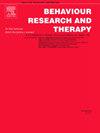专注于同伙还是自己?实时在线视频通话中社交焦虑个体的注意偏差和状态焦虑
IF 4.5
2区 心理学
Q1 PSYCHOLOGY, CLINICAL
引用次数: 0
摘要
对威胁刺激的注意偏向和高度的自我集中注意是高度社交焦虑的激活和延续的关键因素。由于实验任务和材料的不同,关于外部社会线索和自我相关信息之间注意偏差的文献得出了不一致的结果。本研究利用视频会议平台和眼动追踪技术,评估了不同性别、不同社会焦虑水平(n = 82)的个体在不同社会语境(言语和对话)和社会反馈(积极、中性和消极)下的自我和他人相关线索之间的状态焦虑和注意偏差。眼动数据显示,在在线视频互动中,人们更关注他人而不是自己。然而,与社交焦虑程度较低的人相比,高度社交焦虑的人往往更关注自己,而不太关注他人,尤其是男性。高度社交焦虑的男性在社交伴侣和自己之间的注意力分配是平等的,而高度社交焦虑的女性则不是这样。自我报告的数据表明,演讲时的焦虑程度高于交谈时。与社交焦虑程度低的人相比,社交焦虑程度高的人在执行任务时表现出与基线水平的显著差异。主观焦虑在负面反馈中比在中性或积极反馈中更为明显,尤其是在女性中。这些发现加强了对高社交焦虑个体注意偏差的理解,并表明视频会议可能有益于社交焦虑障碍个体的治疗。本文章由计算机程序翻译,如有差异,请以英文原文为准。
To focus on a confederate or oneself? Attentional bias and state anxiety in socially anxious individuals during real-time online video calls
Attentional bias toward threatening stimuli and heightened self-focused attention are pivotal factors in the activation and perpetuation of high social anxiety. Literature on attentional biases between external social cues and self-relevant information has yielded inconsistent findings due to diverse experimental tasks and materials. With a videoconferencing platform and eye-tracking technology, this study assessed state anxiety and attentional bias between self- and other-related cues among individuals with different sex and social anxiety levels (n = 82) in various social contexts (speech and conversation) and social feedback (positive, neutral, and negative). Eye-movement data revealed that individuals focus more on the other person than themselves during online video interactions. However, individuals with high social anxiety tend to focus more on themselves and less on others compared to those with low social anxiety, particularly in males. Males with high social anxiety distributed their attention equally between their social partners and themselves, while females with high social anxiety did not. Self-reported data indicated higher anxiety during speeches than conversations. Those with high social anxiety showed significant differences from baseline levels during tasks, in contrast to those with low social anxiety. Subjective anxiety was more pronounced for negative feedback than for neutral or positive feedback, especially in females. These findings enhance understanding of attentional biases in individuals with high social anxiety and suggest that videoconferencing could benefit therapy for individuals with social anxiety disorder.
求助全文
通过发布文献求助,成功后即可免费获取论文全文。
去求助
来源期刊

Behaviour Research and Therapy
PSYCHOLOGY, CLINICAL-
CiteScore
7.50
自引率
7.30%
发文量
148
期刊介绍:
The major focus of Behaviour Research and Therapy is an experimental psychopathology approach to understanding emotional and behavioral disorders and their prevention and treatment, using cognitive, behavioral, and psychophysiological (including neural) methods and models. This includes laboratory-based experimental studies with healthy, at risk and subclinical individuals that inform clinical application as well as studies with clinically severe samples. The following types of submissions are encouraged: theoretical reviews of mechanisms that contribute to psychopathology and that offer new treatment targets; tests of novel, mechanistically focused psychological interventions, especially ones that include theory-driven or experimentally-derived predictors, moderators and mediators; and innovations in dissemination and implementation of evidence-based practices into clinical practice in psychology and associated fields, especially those that target underlying mechanisms or focus on novel approaches to treatment delivery. In addition to traditional psychological disorders, the scope of the journal includes behavioural medicine (e.g., chronic pain). The journal will not consider manuscripts dealing primarily with measurement, psychometric analyses, and personality assessment.
 求助内容:
求助内容: 应助结果提醒方式:
应助结果提醒方式:


